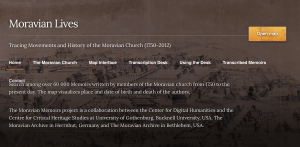Creating digital artifacts from archival documents has allowed for historical documents to become more accessible. For those who are interested in viewing and researching such topics related to those artifacts, they are able to view them digitally through websites like the ones we have explored in class. The benefits of utilizing digital artifacts is that it decreases the chances of them being destroyed. Over time many of these documents can get lost, so converting them into a digital form will help prevent this from happening. A disadvantage to this method is that when they become digitized, the person who is transcribing them could be challenged by the language or handwriting of the artifact. Important information could have the potential to get lost in this process.

After exploring the Moravian Lives project, I was able to connect it to the other large-scale DH projects we have explored because of how interactive it was. Many of these projects take old archives and make them more interesting with a technological twist that is both educational and involving. Personally, I found the Moravian Lives project website to be the most educational because I was interacting with the artifacts. I was plugging in information and learning about the different migration routes that people took from the Moravian Church. This website and the Old Weather website also allow people to add their own contributions to the project by helping transcribe. In addition, already transcribed material is easily accessible on these website. Viewers can access this material at any point.

Since transforming historical texts can sometimes inadvertently remove the history of the actual artifact, transcribers can work to create an online reading interface that still presents the history of the document. It could be something as simple as photoshopping the transcribed digital artifact onto the document. Also, if it is possible, the website could include a 360 degree view of the artifact so that the viewer could gain full experience as if being in the actual presence of it. I know that it is very hard to completely replicate the idea of reading an actual artifact, but creating a way that the viewer can both see and move the document digitally is very close to replicating the physical experience of reading it.
Because these websites are easily accessible, it has allowed for a shift in educational opportunities. Students can now access historical documents at any point in their education due to the work that transcribers have done. These documents might be ones that students would have never been able to see if it weren’t for their digitization. Though they are not provided with a hard copy of the material, what they can access is free and attainable. This material can provide educational experiences, just like the Moravian Lives project, that contains interactive material that can benefit many students learning experiences. Digital artifacts has greatly enhanced educational experiences for students around the world because it has combined historical artifacts with modern day technology to create a way that everyone can enjoy history.
Olivia Smith is a student at Bucknell University in Lewisburg, Pennsylvania. She was born and raised in Manasquan, New Jersey. She is currently apart of the Bucknell Women’s Rowing Team and plans to major in Psychology and Creative Writing.





